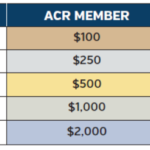In November, RheumPAC will be leading its annual matching campaign and hosting two events at ACR Convergence 2022. Thanks to matching donors, every contribution in November will be amplified.

Subcategories:EthicsLegal UpdatesLegislation & AdvocacyResearch Rheum
The ACR/CHEST ILD Guidelines in Practice, a video
In collaboration with the American College of Chest Physicians, the ACR released two new comprehensive guidelines aimed at improving the screening, monitoring, and treatment of patients with interstitial lung disease (ILD) secondary to systemic autoimmune rheumatic diseases (SARDs). Recently, Sindhu R. Johnson, MD, PhD, professor of medicine at the University of Toronto, Canada, director of the Toronto Scleroderma Program and principal investigator for the guideline, and Elana J. Bernstein, MD, MSc, Florence Irving associate professor of medicine in the Division of Rheumatology at Columbia University, New York City, and co-first author, presented a webinar to talk about how the guidelines were developed and present some of the recommendations and their rationale: Watch the recording now!

In November, RheumPAC will be leading its annual matching campaign and hosting two events at ACR Convergence 2022. Thanks to matching donors, every contribution in November will be amplified.

Elizabeth "Blair" Solow, MD |
Outgoing Government Affairs Committee Chair Blair Solow, MD, offers advocacy updates from 2022 and seasonal reflections on how to stay focused on efforts that matter when faced with daunting challenges.

A study from Glerup et al. demonstrated that many patients with juvenile idiopathic arthritis achieved drug-free remission over 18 years of follow-up and that remission rates remained stable between years 8 and 18 of the study period.

Emily A. Johnson, JD |
Healthcare businesses are a hot commodity in the market today. A buyer may even be interested in your healthcare practice right now. Whether or not you’ve gone down the road of selling your practice before, the process can be stressful and time consuming. A lot of the time and stress centers around one aspect of…

Daniel K. White, PT, ScD, MSc, & Susan Bartlett, PhD |
High-quality mentoring is perhaps the most recognized ingredient to a successful career, one that remains little understood. Here, we present a brief overview of the elements of successful mentor-mentee relationships for clinicians and scientists in rheumatology. We discuss the importance of mentorship and characteristics of good mentoring, and offer our personal reflections as both mentees…

WASHINGTON, D.C.—On Sept. 14, the ACR praised the House of Representatives for overwhelmingly passing bipartisan legislation intended to make it easier for Medicare Advantage beneficiaries to access the timely care they need. The Improving Seniors’ Timely Access to Care Act (H.R. 3173) passed the House on a voice vote. If enacted, the bill will create…

Katie Robinson |
The mission of the Rheumatology Research Foundation, a division of the ACR, is to advance research and training to improve the health of patients living with rheumatic disease. It supports career advancement, mentorship, professional development and education of professionals working in the disciplines essential to these patients.1 “The Foundation understands that the support of Association…
Patient stories are a powerful way to highlight ways that healthcare policies affect the everyday lives of people with rheumatic diseases.

Leslie Mertz, PhD |
The American Medical Association’s Relative Value Update Committee advises the Centers for Medicare & Medicaid Services on appropriate reimbursement rates for specialty services. Luke Barré, MD, MPH, RhMSUS, is learning the ropes as the ACR’s newest representative.
Similar patterns of inflammation occur in the joints of patients with inflammatory arthritis, but in each individual, arthritis affects only a subset of possible anatomic areas. Chang et al. set out to identify patient-specific anatomic patterns of joint flare to distinguish local from systemic drivers of chronic disease.